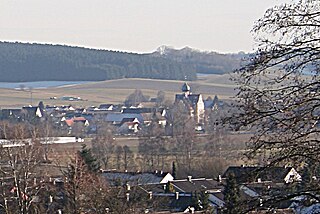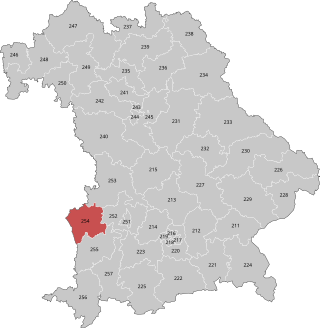
Swabia is one of the seven administrative regions of Bavaria, Germany. It consists of ten districts and 340 municipalities with Augsburg being the administrative capital. It is the only german region officially be named Swabia in the principle of spatiality.
Günzburg is a Landkreis (district) in Swabia, Bavaria, Germany. Its capital is the town Günzburg. It is bounded by the districts of Dillingen, Augsburg, Unterallgäu and Neu-Ulm, and by the state of Baden-Württemberg.
Pfaffenhofen is a Landkreis (district) in Bavaria, Germany. It is bounded by the districts of Eichstätt, Kelheim, Freising, Dachau and Neuburg-Schrobenhausen, and the city of Ingolstadt.

Günzburg is a town in Bavaria, Germany. It is a Große Kreisstadt and the capital of the Swabian district Günzburg. This district was constituted in 1972 by combining the city of Günzburg – which had not previously been assigned to a Kreis (district) – with the district of Günzburg and the district of Krumbach.
Neuburg or Neue Burg can refer to:

Neuburg an der Donau is a town which is the capital of the Neuburg-Schrobenhausen district in the state of Bavaria in Germany.

Krumbach is a town with 13,000 residents in the district Günzburg in Swabia, Bavaria, Germany. It is the second biggest town in the district.

Thannhausen is a town in the district of Günzburg, in Bavaria, Germany. It is situated on the river Mindel, 24 kilometres (15 mi) southeast of Günzburg, and 33 kilometres (21 mi) west of Augsburg.
Ursberg Abbey is a former Premonstratensian monastery, now a convent of the Franciscan St. Joseph's Congregation, situated in the small village of Ursberg in the district of Günzburg, Bavaria.

Ursberg is a municipality in the district of Günzburg in Bavaria in Germany.

Niederraunau is a quarter of the town Krumbach in Günzburg (district), Swabia, Bavaria, Germany.

The Iller-Lech Plateau, also known as the Upper Swabian Plateau, is one of the natural regions of Germany.

The Kammel is a river in Bavaria, southern Germany. The Kammel originates west of Mindelheim, in the district Unterallgäu, and flows generally north. It flows into the Mindel south of Offingen at the Danube, east of Günzburg in the district Günzburg. So it is an indirect right tributary of the Danube. The difference in altitude between the origin and the mouth is 265 m.

The Bundesstraße 16 or B 16 is one of the German federal highways crossing southern Bavaria from east to south. It runs from the Bavarian Forest to Regensburg and then along the river Danube to Günzburg. From Roding to Regensburg the highway is developed without any junctions and is in parts signed as B 16n. From Günzburg to Füssen the B 16 runs from north to south.

The Augsburg-Western Woods Nature Park is one of the two nature parks in Bavarian Swabia. The 1988 founded park has a size of 1,175 km2 (454 sq mi). The nature park is bordered by the rivers Danube, Wertach, Schmutter, Flossach and Mindel. The biggest part of it is located in Augsburg (district) and extends to the edge of the districts Unterallgäu, Günzburg (district) and Dillingen (district).
Hürben, today the eastern part of Krumbach in Bavarian Swabia, was an independent village before it was incorporated into the neighbouring town of Krumbach in the year 1902. The Kammel was in most parts the border between Krumbach and Hürben.

The Monastery Edelstetten is a former Kanonissenstift convent located at 48°17′N 10°22′E in the city of Edelstetten, a municipality of Neuburg an der Kammel in Bavaria, Germany. The monastery is in the diocese of Augsburg and in the valley of the Haselbach River.

Augsburg-Land is an electoral constituency represented in the Bundestag. It elects one member via first-past-the-post voting. Under the current constituency numbering system, it is designated as constituency 252. It is located in southwestern Bavaria, comprising most of the Landkreis Augsburg and Aichach-Friedberg districts.

Neu-Ulm is an electoral constituency represented in the Bundestag. It elects one member via first-past-the-post voting. Under the current constituency numbering system, it is designated as constituency 254. It is located in southwestern Bavaria, comprising the Günzburg and Neu-Ulm districts.















